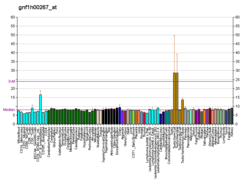G2/M phase-specific E3 ubiquitin-protein ligase is an enzyme that in humans is encoded by the G2E3 gene.[5][6][7]
References
- 1 2 3 GRCh38: Ensembl release 89: ENSG00000092140 - Ensembl, May 2017
- 1 2 3 GRCm38: Ensembl release 89: ENSMUSG00000035293 - Ensembl, May 2017
- ↑ "Human PubMed Reference:".
- ↑ "Mouse PubMed Reference:".
- ↑ Brooks WS, Helton ES, Banerjee S, Venable M, Johnson L, Schoeb TR, Kesterson RA, Crawford DF (Aug 2008). "G2E3 is a dual function ubiquitin ligase required for early embryonic development". J Biol Chem. 283 (32): 22304–15. doi:10.1074/jbc.M803238200. PMC 2494922. PMID 18511420.
- ↑ Brooks WS, Banerjee S, Crawford DF (Feb 2007). "G2E3 is a nucleo-cytoplasmic shuttling protein with DNA damage responsive localization". Exp Cell Res. 313 (4): 665–76. doi:10.1016/j.yexcr.2006.11.020. PMC 1876774. PMID 17239372.
- ↑ "Entrez Gene: KIAA1333 KIAA1333".
Further reading
- Maruyama K, Sugano S (1994). "Oligo-capping: a simple method to replace the cap structure of eukaryotic mRNAs with oligoribonucleotides". Gene. 138 (1–2): 171–4. doi:10.1016/0378-1119(94)90802-8. PMID 8125298.
- Suzuki Y, Yoshitomo-Nakagawa K, Maruyama K, et al. (1997). "Construction and characterization of a full length-enriched and a 5'-end-enriched cDNA library". Gene. 200 (1–2): 149–56. doi:10.1016/S0378-1119(97)00411-3. PMID 9373149.
- Nagase T, Kikuno R, Ishikawa KI, et al. (2000). "Prediction of the coding sequences of unidentified human genes. XVI. The complete sequences of 150 new cDNA clones from brain which code for large proteins in vitro". DNA Res. 7 (1): 65–73. doi:10.1093/dnares/7.1.65. PMID 10718198.
- Crawford DF, Piwnica-Worms H (2001). "The G(2) DNA damage checkpoint delays expression of genes encoding mitotic regulators". J. Biol. Chem. 276 (40): 37166–77. doi:10.1074/jbc.M103414200. PMID 11483598.
- Strausberg RL, Feingold EA, Grouse LH, et al. (2003). "Generation and initial analysis of more than 15,000 full-length human and mouse cDNA sequences". Proc. Natl. Acad. Sci. U.S.A. 99 (26): 16899–903. doi:10.1073/pnas.242603899. PMC 139241. PMID 12477932.
- Lehner B, Semple JI, Brown SE, et al. (2004). "Analysis of a high-throughput yeast two-hybrid system and its use to predict the function of intracellular proteins encoded within the human MHC class III region". Genomics. 83 (1): 153–67. doi:10.1016/S0888-7543(03)00235-0. PMID 14667819.
- Ota T, Suzuki Y, Nishikawa T, et al. (2004). "Complete sequencing and characterization of 21,243 full-length human cDNAs". Nat. Genet. 36 (1): 40–5. doi:10.1038/ng1285. PMID 14702039.
- Gerhard DS, Wagner L, Feingold EA, et al. (2004). "The status, quality, and expansion of the NIH full-length cDNA project: the Mammalian Gene Collection (MGC)". Genome Res. 14 (10B): 2121–7. doi:10.1101/gr.2596504. PMC 528928. PMID 15489334.
- Rual JF, Venkatesan K, Hao T, et al. (2005). "Towards a proteome-scale map of the human protein-protein interaction network". Nature. 437 (7062): 1173–8. doi:10.1038/nature04209. PMID 16189514.




